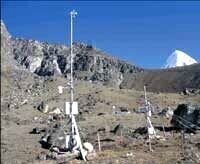Environmental Laboratory
SHARE Everest 2008: Extreme Weather Monitoring
Jul 02 2008
SHARE Everest 2008 mission has installed on South Col – Everest (8.000 metres above sea level) the LSILASTEM AWS 8000 monitoring station, which has been made for very high altitudes and is suitable for extreme
conditions.
It’s an unmanned station and it can only be reached twice a year: May and September. The telemetry connection between the station and the pyramid Laboratory-Observatory of EvK2CNR Committee (manned site) happens through radio link at Kala Patthar 5500 metres altitude (unmanned but easily attainable site) and reaches the Nepal Climate Observatory-Pyramid station at 5079 metres altitude connected to
LAN from Pyramid.
ASW 8000 is the real heart of the system, and manages the data acquisition, the processings, the storage, the timed transmission and the synchronisation of all radio-modems.
The station can transfer the collected data to distance of about ten kilometres and over. The power supply is by means of small solar panels and high efficiency batteries. Sherpas have arranged the transport
up to the installation site, and in order to do it the station
has been dismantled obtaining 15 parcels that could be easily reassembled; max weight of each parcel 15 kg.
These are the measured and transferred parameters:
• temperature
• humidity
• pressure
• wind direction and intensity
• total sun radiation
• ultraviolet radiation
E-Log is LSI-LASTEM data logger for environmental applications, and itmanages the collection, storage and control of data coming from connected sensors. Thanks to its low power consumption, its protection against heavy environmental conditions and possible overvoltages, and thanks to the range of signals it can receive, E-Log is suitable to measure outdoor meteorological, hydrological conditions, and to operate
in extreme environments. Main characteristics of E-Log:
• N.8 universal analogue inputs, N.4 impulsive inputs/digital state. Management up to 99 channels for sensors with serial o radio output.
• N.7 independent actuation outputs for feeding of sensors or communication equipments or for signaling of alarms by means of pre-configured logics.
• Very low power consumption (• Management (in one second) up to 99 measures acquired from sensors or derived.
• 2 Mb Fixed storage Flash type.
• N.2 RS232 ports with LSI-LASTEM protocols, Modbus RTU, TTY.
• Calculation of derived measures
• Acquisition gap for each input programmable from
1 sec. to 1 hour
• Statistic processing gap programmable from 1 sec.
to 24 hours
• Connection to PC through serial line RS232/485/radio/modem PSTN/GSM/GPRS/Ethernet
• Bit rate programmable from 1200 bps to 115.2 kbps
• Display of acquired data and operation diagnostic state
• Display of operation/error state through led on frontal panel
• Possibility of connecting several instruments in order to increase the number of inputs
Telemetry system:
• Telemetry of AWS 8000 station through UHF band, the radio-modem broadcasts up to 8000 meters altitude with output-power up to 1 Watt, and has same characteristics of environmental resistance like AWS
8000, minimum power consumption in standby and slightly directional aerial (Yagi 2 elements) with radiation efficiency at Kala Patthar.
• The repeater installed on Kala Patthar (with possibility of connecting PC to RS232 serial line for diagnostic purposes), is equipped with high gain directional aerial (Yagi 6 elements) which’s trained at South Col.
• Master station has been installed at Pyramid, and it consists of radio modem, which includes DC/AC power supply and RS232 interface at dedicated computer that connects to Pyramid data connection through LAN. This station requests Kala Patthar for data download, Kala Patthar requests South Col station the same data, and South Col answers
supplying the data. During this process occurs the synchronisation of data-logger’s clocks, which handle operation/stand-by times, or data communication.
The instruments have been tested at hypobaric chamber of Centro Sperimentale Medicina Aerospaziale in Pratica di Mare (Rome) in order to check the stability of measurements at high altitudes. During first tests had been found some operation anomalies, due to both low
pressure and low temperature. Afterwards the instruments have been improved granting them maximum reliability.
Digital Edition
IET 34.2 March 2024
April 2024
Gas Detection - Biogas batch fermentation system for laboratory use with automatic gas analysis in real time Water/Wastewater - Upcycling sensors for sustainable nature management - Prist...
View all digital editions
Events
Apr 22 2024 Hannover, Germany
Apr 22 2024 Marrakech, Morroco
Apr 23 2024 Kuala Lumpur, Malaysia
Apr 23 2024 Kintex, South Korea
Apr 23 2024 Edmonton, AB, Canada


















